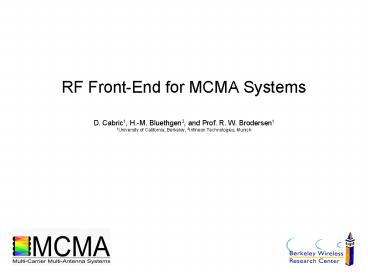RF FrontEnd for MCMA Systems PowerPoint PPT Presentation
1 / 10
Title: RF FrontEnd for MCMA Systems
1
RF Front-End for MCMA Systems
- D. Cabric1, H.-M. Bluethgen2, and Prof. R. W.
Brodersen11University of California, Berkeley,
2Infineon Technologies, Munich
2
Objective
- Design RF front end compatible with the BEE
platform for Multi-Carrier Multi-Antenna (MCMA)
systems - Specify front-ends architecture and components
- Provide flexibility to append further up/down
conversion stages (e.g. 24 GHz and 60 GHz)
3
Design Considerations
- Each antenna RF chain requires
- Dual DAC board, dual ADC board, antenna, control
signals, power supply - Interface with the BEE board
- Clean clock sources for ADC and DAC
- I/Q channel data buses
- RF gain control for the AGC
- Phase noise of sample clocks
- How are different sample clock phases affecting
the system? - What is the tolerance in the misalignment of
transmitted symbols? - Same problem applies to the receiver sampling
- Phase noise of IF and RF signals
- Can we use seperate PLLs for all channels?
- Alternatively, we can use a common carrier signal
produced externally(IF/RF signal generator)
4
Optimal Architecture
- All RF transceivers for multi-antenna system
integrated on one board - All up-/down-conversion mixers fed by common
reference signals
- Common phase noise on each antenna branch
- Good matching of all components and signals on
the board - Less components
- Compact, easier to calibrate and handle
- Fixed number of antennas
- Requires dedicated PCB design
5
Alternative Architecture
- One separate board for each antenna
- One PLL on each board
- Single LO to generate IF and RF frequencies
- Arbitrary number of antennas
- Flexible and reusable
- Commercial front-ends available
- Need to program each PLL individually
- After PLL phase noise is different on each
antenna
6
Available Single-Antenna Front-End Reference
Designs
7
FPGA Implementation of a Narrow-Band
Transmission System
Transmitter
Simulink Model of Transmission System
Receiver
8
Implementation onPicoNode 2 Board
Channel
Receiver
Transmitter
Tx I
Rx I
Out1
I
I
Out2
Q
Q
Ctrl
Ctrl
Tx Q
Rx Q
Simulink Model
System Generator
System Generator
BEE Design Flow
BEE Design Flow
BitstreamFile
BitstreamFile
FPGA
FPGA
FPGA
RF Front-End
ADC/DAC
PN2 Board 1
PN2 Board 2
M. Kuulusa, PicoNode 2 Prototype, BWRC Summer
Retreat 2002
9
Measurements
Tx Output Spectrum
Eye Diagram
Constellation Diagram
RF Front-EndA/D Conv.
10
Outlook
- Determine and characterize all contributing noise
sources - Quantitative comparison of architecture
alternatives - Derive a model for simulations from measurements
- Use simulation model to extend single-antenna
results to multi-antenna system - Consideration of different multi-element antenna
configurations - Specification for RF front-end
- Implementation of parallel multi-antenna front-end

